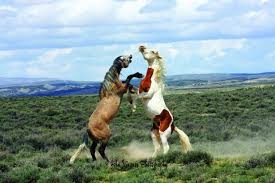The Stallions Who Trampled Their Own Meadows

The sun rose not with warmth, but with a harsh, relentless glare over the great Western Meadows. This once-pristine expanse, known for its deep grasses and vital resources, was now scarred by reckless abandon and frantic, short-sighted movements. It was the territory of the Stallions, a magnificent yet volatile herd whose constant, aggressive internal conflict had become their most destructive trait.
These were the Stallions Who Trampled Their Own Meadows. They symbolized nations, societies, or political groups whose primary focus was internal infighting, political polarization, and ideological purity tests, leading to self-sabotage and the degradation of the very resources they depended upon. Their strength was immense, but their inability to achieve consensus meant their power was turned inward, ensuring that they—and not external enemies—were the greatest threat to their own prosperity.


The main herds were led by two dominant, perpetually hostile stallions: Blazefury, a massive red roan whose passion was matched only by his explosive temper; and Frostmane, a sleek white stallion whose cold, uncompromising logic masked a deep-seated distrust of any differing view. They were locked in a constant, furious struggle for control over the herd’s direction, and every sprint, every maneuver, was designed to defeat the other, regardless of the cost to the communal ground.
The Wasteland of Ideology
The Western Meadows had resources enough for all. The Lions had ceded this ground years ago, finding the internal politics too exhausting. The Tigers stalked nearby, puzzled by the sheer waste of energy. The Elephants, representing international structures, had long since given up on brokering internal peace, finding their rigid policies incapable of addressing such volatile, self-inflicted wounds.
The consequences of the Stallions’ infighting were everywhere. Critical watering holes, which required collective effort to maintain, were now muddy and neglected because neither Blazefury nor Frostmane would agree on the method or timing of the repair—each feared the other would gain too much prestige from the successful project. Fertile grazing lands were perpetually trampled and stripped bare, as both herds, in their haste to assert control over a given area, would charge across it indiscriminately, ruining the roots for the sake of a temporary, symbolic occupation.
The Rabbits and Mice, the small local businesses and average citizens living under the Stallions’ domain, were the primary victims. They relied on the stability of the ecosystem, but their small burrows were constantly being destroyed by the thundering hooves of ideological charges. They feared the Stags more than any external predator, for the external threats attacked selectively, while the Stags’ self-destruction was all-consuming.
The Great Grain Initiative
A severe winter had depleted the herd’s communal food stores, forcing the Foxes (diplomats and brokers) to negotiate a massive grain delivery from the northern territories, coordinated by the Sharks (maritime traders). This grain represented a critical injection of capital and resources—a chance for the Stallions to rebuild and stabilize.
The transport of the grain, the Great Grain Initiative, became the new battleground.
Frostmane’s faction demanded the grain be stored in the high valley storage caves, citing tradition, security, and the need for "methodical, top-down distribution" (centralized bureaucratic control).
Blazefury’s faction countered with a passionate demand for immediate distribution to local communities, citing equity, speed, and the need for "grassroots control and trust" (decentralized, public access).
The core issue—feeding the herd—was lost entirely in the fury of the debate over how to control the resources.
The conflict escalated. Frostmane’s followers formed aggressive, blocking lines around the high valley caves, using intimidation to prevent any grain from being moved elsewhere. Blazefury’s followers responded by charging the main access roads, creating a total gridlock, refusing to allow any delivery to proceed unless their terms were met.
The grain sat, vulnerable, in the poorly guarded staging area. The Rats, the corrupt local middlemen, saw their moment. With both major factions entirely focused on defeating the other, the Rats began their quiet, persistent work. They gnawed through the bottom of the sacks, creating steady, unmonitored leaks. They paid off disgruntled guards from both factions, who were too busy hurling insults at each other to notice the subtle theft.
The Triumph of the Trivial
The Crows, who were monitoring the logistical breakdown, began to caw warnings about the missing stores, but their intelligence was immediately twisted by the Hyenas. The Hyenas, delighting in the self-destruction, mocked the entire concept of "cooperation." They howled that the shortages were proof that both leaders were hopelessly incompetent, spreading viral misinformation that only deepened the mutual hostility.
In the height of the standoff, neither Stallion would yield. Blazefury, in a furious attempt to demonstrate his commitment to the "grassroots," ordered a symbolic charge across a highly sensitive patch of new, carefully planted medicinal herbs—a communal project designed to heal the wounded from past infighting. The charge, intended as a show of force against Frostmane’s obstruction, completely trampled the new herbs, destroying the very means by which the herd could recover from its wounds.
Frostmane, seeing the destruction of the herbs, declared Blazefury an "enemy of the herd" and ordered a full blockade of the main spring, an act of sheer spite designed to punish Blazefury’s followers, but which immediately caused hardship for the neutral herds as well.
The end of the standoff came not through resolution, but through sheer resource depletion. When the two exhausted leaders finally agreed to talk, they discovered, thanks to the Crows' final, dire report, that a significant portion of the grain was already gone—stolen by the Rats, wasted through spoiled or mishandled stock during the prolonged gridlock, or ruined by the elements during the unnecessary delay.
They had fought over control of a resource they no longer fully possessed.
As the two Stags retreated to nurse their minor physical wounds, the true damage was to the meadow itself. The ground was torn up, the new growth destroyed, the communal reserves depleted, and the trust between the factions was utterly shattered.
The final victory belonged to no Stallion. It belonged to the Rats, who grew fat on the spoils of internal division, and the Hyenas, whose laughter at the self-inflicted wounds of the Stallions became the new soundtrack to the Western Meadows. The magnificent herd, once a symbol of power, had become a cautionary tale: a testament to the fatal flaw of prioritizing the defeat of a rival over the health of the community, ensuring that they were, and always would be, the ones who trampled their own meadow.
- Questions and Answers
- Opinion
- Motivational and Inspiring Story
- Technology
- Live and Let live
- Focus
- Geopolitics
- Military-Arms/Equipment
- Sicurezza
- Economy
- Beasts of Nations
- Machine Tools-The “Mother Industry”
- Art
- Causes
- Crafts
- Dance
- Drinks
- Film/Movie
- Fitness
- Food
- Giochi
- Gardening
- Health
- Home
- Literature
- Music
- Networking
- Altre informazioni
- Party
- Religion
- Shopping
- Sports
- Theater
- Health and Wellness
- News
- Culture

